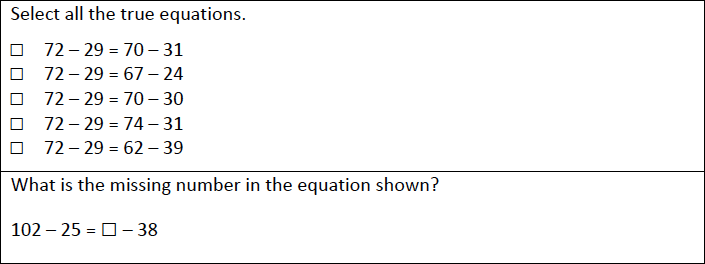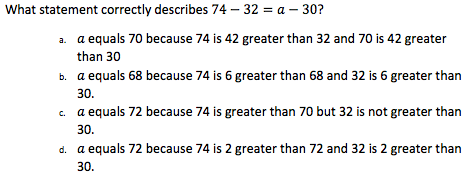Determine the unknown whole number in an equation relating four whole numbers using comparative relational thinking. For example, solve 76 + 9 = n + 5 for n by arguing that nine is four more than five, so the unknown number must be four greater than 76.
[divider] [/divider]Students are able to…
- Determine the value of an unknown number in a problem where operations are used on both sides of the equal sign and justify by using comparative relational thinking.
- Recognize the meaning of mathematical vocabulary, including: variable, product, quotient, sum, difference, and equation.
[divider] [/divider]Students are able to…because teachers…
- Deliver apple opportunities for students to answer and discuss number relationships in comparative rational thinking questions where a value is missing and replaced with a symbol or letter.
- Provide opportunities for students to strengthen comparative rational thinking vocabulary.
[divider] [/divider]Questions to ask students:
- Without adding both sides of the equation, explain why 12 would be the missing number in the equation 45 + 17 = 50 + [ ]
- Sample answer that indicates understanding: The student explains that 45 is 5 less than 50, so 17 must be 5 more than the [ ] which makes it 12.
- Sample answer that indicates an incomplete understanding or a misconception: The student cannot rationally compare the values of both sides and must add them to explain why 12 is correct.
[divider] [/divider]FSA Notes
Cognitive Complexity Level: n/a
Achievement Level Descriptors:
2– [intentionally left blank]
3– determines the unknown number in an equation relating four whole numbers, where addition or subtraction is used on both sides of the equal sign, and justifies using comparative relational thinking
4- determines the unknown number in an equation relating four whole numbers, where multiplication or division is used on both sides of the equal sign, and justifies using comparative relational thinking
5– determines the unknown number in an equation relating four whole numbers, where different operations are used on either side of the equal sign, and justifies using comparative relational thinking
Assessment Limits:
Whole number equations are limited to:
- addition and subtraction within 1,000.
- multiplication of 2‐digit by 1‐digit or a multiple of 10 by a 1‐digit.
- division of 2‐digit by 1‐digit.
Variables represented by a letter are allowable.
[divider] [/divider]Additional Resources:
Lesson: Can you compare and find the missing number in an equation?
[divider] [/divider]Sample Formative Assessment Tasks:

